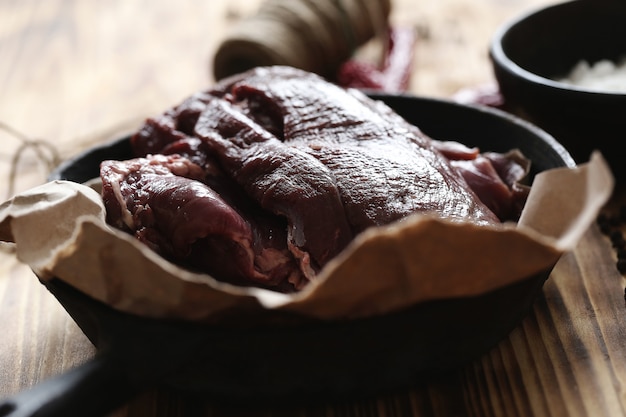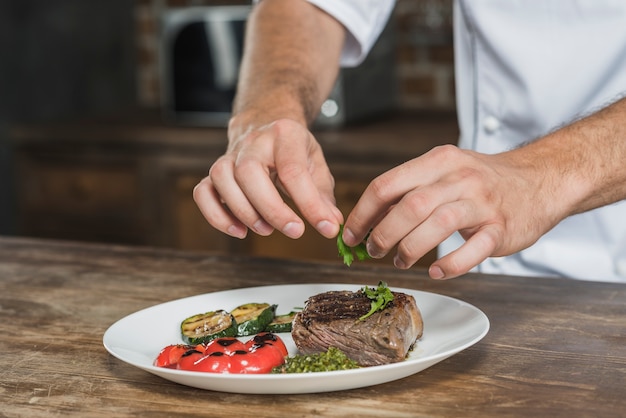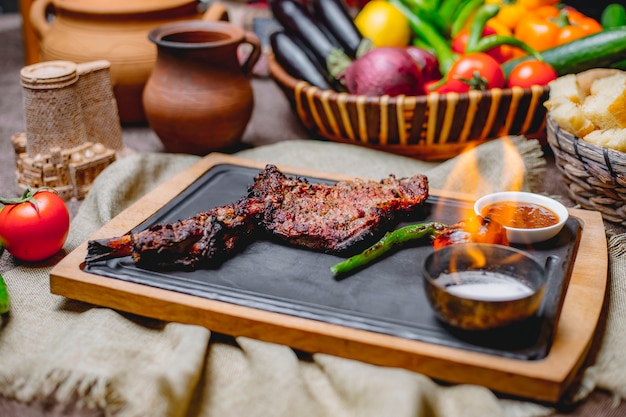As a self-proclaimed foodie, there's nothing I love more than a perfectly cooked prime rib. It's a dish that always impresses guests and leaves everyone wanting more. But let's be honest, getting that roast right can be a bit of a challenge. It's not just about throwing a piece of beef in the oven and hoping for the best. You need to understand the process, the nuances, and the little tricks that make all the difference. That's why I'm sharing my years of experience and tips to help you master the art of prime rib cooking. This is your comprehensive guide to transforming a humble cut of meat into a culinary masterpiece, from choosing the perfect cut to crafting the most delicious gravy. Let's embark on this delicious journey together!
Part 1: The Prime Rib Primer

choosing the right cut: A Culinary Odyssey
The first step in our prime rib adventure is selecting the right cut. We're not talking just any old piece of beef here. We're after a prime cut, specifically from the rib section, where the meat is known for its rich flavour and tenderness.
The two most popular cuts for prime rib are:
- Standing rib roast: This is the classic, bone-in choice. It's a true showstopper, perfect for a special occasion or feeding a crowd. The bone adds a depth of flavour and that "wow" factor, making it a true centerpiece.
- Rib Roast: This is a boneless option, ideal if you want a roast that's easier to slice and serve. It tends to cook more evenly, making it a good choice for those who prefer less fuss.
Personally, I'm a big fan of the standing rib roast. There's something about that bone-in piece that screams "celebration." Plus, the bone adds a unique flavour that's just irresistible. It’s all about that primal, satisfying feeling, you know?
Understanding the Grades: The Marbling Matters
Once you’ve chosen your cut, it's time to consider the grade. The USDA grading system is based on the amount of marbling, or fat, within the meat, which directly influences flavour and tenderness. Here's a quick rundown:
- Select: This is the leanest option, with minimal marbling. It can be a bit dry, so it's not the best choice for a prime rib roast, where juiciness is key.
- Choice: This is the most common grade and offers a good balance of flavour and tenderness. It's a solid choice for a delicious roast.
- Prime: This is the highest grade, boasting the most marbling. It's super juicy and flavourful, perfect for a special occasion or when you want to indulge in the ultimate prime rib experience.
For the ultimate prime rib experience, I always go for Prime. It's a splurge, but the flavour and tenderness are well worth it. You won't regret the decision, I promise.
Size Matters: Feed the Crowd
Choosing the right size roast is crucial. You don't want to end up with a mountain of leftovers (though that's a good problem to have!), or worse, not enough to go around. A good rule of thumb is to allow about 1 pound of prime rib per person. I always err on the side of caution and get a bit more, just in case. You can always freeze any leftovers for another delicious meal.
Get the Bone Right: A Choice of Techniques
If you've opted for a standing rib roast, you'll need to decide whether to leave the bone in or remove it. Leaving the bone in helps to keep the roast moist and adds that extra flavour, but it can make carving a bit trickier.
I’ve found that both options have their merits. Leaving the bone in offers that classic prime rib experience, while removing it simplifies carving and can be more convenient for some. Ultimately, the decision is yours. If you’re feeling adventurous, leave it in! But, if you prefer a less complicated approach, have the butcher remove the bone for you.
Part 2: Prepping the perfect roast: The Art of Flavor

Seasoning and Salting: A Symphony of Spices
Now, this is where things start to get really exciting. You've got your beautiful prime rib, ready to go, but don’t just slap some salt and pepper on it and call it a day. We're aiming for flavour perfection here.
My go-to seasoning for prime rib is a simple blend of salt, pepper, garlic powder, onion powder, and paprika. The salt enhances the natural flavour, the pepper adds a bit of heat, and the garlic and onion powder bring depth and complexity. You can also add a pinch of rosemary or thyme for extra flavour, but remember, it's all about balance. Don’t go overboard. We want to let the beautiful flavour of the prime rib shine through.
Dry Brining: A Secret for Juicy Perfection
Here’s where things get interesting – dry brining. This is one of my biggest secrets for juicy, flavourful prime rib. It involves rubbing the roast with a generous amount of salt and leaving it uncovered in the fridge for 12-24 hours. The salt draws out the moisture from the meat, then reabsorbs it along with the salt, resulting in a tender, succulent roast. I always dry brine my prime rib, and the difference is astounding. It’s a simple technique that makes a world of difference in flavour and texture.
roasting time: A Culinary Countdown
It's time to get that roast in the oven. First, preheat your oven to 450°F. Then, place the roast on a roasting rack in a large roasting pan. This allows for even heat circulation and prevents the roast from steaming in its own juices. You can also add some water to the bottom of the pan to create steam, which will help keep the roast moist.
Searing for Flavor and Texture
Before you pop the roast in the oven, give it a good sear on all sides. This creates a beautiful crust and locks in the flavour. I like to use a cast iron skillet for this, but you can also use a regular skillet. Just make sure it’s nice and hot. The sizzle should be loud and proud!
The Big Bake: Slow and Steady Wins the Race
Now, the moment of truth. Slide that beautiful roast into the hot oven. The initial high heat will give you that crispy crust we're after. But, we want the roast to cook slowly and evenly, so after 15 minutes, reduce the oven temperature to 325°F.
cooking time will vary depending on the size and thickness of your roast, but a good rule of thumb is about 15-20 minutes per pound for medium-rare. For a medium-well roast, add about 5-10 minutes per pound.
Part 3: The Rest and the Reveal: Letting the Flavour Settle

The Importance of Rest: A Culinary Pause
After the roast has finished cooking, don't be tempted to carve it right away. Give it a good 15-20 minutes to rest. This allows the juices to redistribute throughout the meat, resulting in a much more tender and juicy roast. It's like a culinary pause, letting the flavours settle and meld together.
While the roast is resting, it’s the perfect time to start making the gravy. No prime rib is complete without a delicious gravy to pour over those beautiful slices.
Carving with Confidence: A Masterful Technique
Carving prime rib is a skill, but it's not as difficult as it seems. With the right tools and a bit of practice, you'll be carving like a pro in no time.
First, you'll need a sharp carving knife. A good quality knife will make all the difference. It should be long and thin, with a sharp blade. If you have a standing rib roast with the bone in, you'll also need a meat cleaver to cut between the ribs.
To carve the roast, slice across the grain of the meat. This will ensure that the slices are tender and easy to chew.
Don't be afraid to experiment and find a carving technique that works best for you. Remember, practice makes perfect.
Part 4: The Ultimate Gravy: A Flavorful Finish
Making the Perfect Gravy: A Culinary Masterpiece
The perfect gravy elevates any roast to a whole new level. You want a gravy that's rich, flavorful, and smooth, a perfect complement to the prime rib. Here's how to make the best prime rib gravy you've ever tasted.
First, you’ll need the drippings from the roast. Carefully pour them into a saucepan, leaving any solid bits behind. Add a tablespoon of butter to the pan and stir until melted. This adds richness and depth to the gravy.
Next, whisk in 2-3 tablespoons of flour. Cook the flour for a few minutes, stirring constantly, until it's golden brown. This will help to thicken the gravy and give it a beautiful colour.
Now, it’s time to add the liquid. Slowly whisk in 1-2 cups of beef broth or water. Bring the mixture to a simmer and cook for about 5 minutes, stirring constantly, until the gravy has thickened.
Season the gravy to taste with salt, pepper, and a pinch of garlic powder or onion powder. Strain the gravy through a fine-mesh sieve to remove any lumps.
Serve the gravy immediately over your prime rib slices. It's the perfect way to finish off this delicious meal.
Part 5: side dish Success: Harmonizing Flavors
Complementary Sides: A Symphony of Flavors
No prime rib feast is complete without a selection of delicious side dishes. I’ve put together a list of my favourite pairings, creating a symphony of flavours that complement the richness of the roast.
- Roasted Vegetables: Roasted root vegetables like carrots, potatoes, and parsnips are a classic accompaniment to prime rib. They're simple to prepare and provide a delicious contrast to the rich meat.
- Creamy mashed potatoes: creamy mashed potatoes are another classic choice. They're soft, comforting, and pair perfectly with the richness of prime rib.
- green beans: Green beans are a light and refreshing side dish that complements the richness of prime rib. I love to serve them with a little bit of butter and salt.
- Asparagus: Asparagus is another great option for a lighter side dish. Roast it, grill it, or steam it - whatever you prefer.
- Brussels Sprouts: Don't underestimate the power of Brussels sprouts! Roasted with a bit of bacon and balsamic glaze, they add a delicious smoky and tangy element to the meal.
Part 6: Storage and Leftover Love: Making the Most of Your Roast
Storing the Prime Rib: Keeping It Fresh
If you have any leftover prime rib, you can store it in an airtight container in the refrigerator for up to 3-4 days. Just make sure to let it cool down completely before storing.
Leftover Magic: Transforming Deliciousness
Leftover prime rib is a culinary goldmine. It can be used in so many delicious ways. Here are a few ideas:
- Prime Rib Sandwiches: Slice the leftover prime rib and pile it onto toasted bread with some of your favourite toppings. I like to add a dollop of horseradish cream, a few slices of tomato, and some arugula.
- Prime Rib Soup: Leftover prime rib makes a delicious and hearty soup. Simply simmer it with vegetables, broth, and your favourite spices.
- Prime Rib Pizza: Top a pizza crust with leftover prime rib, cheese, and your favourite toppings.
- Prime Rib Hash: Dice leftover prime rib and saute it with potatoes, onions, and your favourite spices.
- Prime Rib Tacos: Warm up the leftover prime rib and shred it. Fill tortillas with the shredded meat, your favourite toppings, and a dollop of sour cream or salsa.
Part 7: Wine Pairings: Elevating the Experience
The Perfect Wine Companion: Complementary Flavors
No prime rib feast is complete without the perfect wine to pair with it. I’ve found that red wines with bold flavours and rich tannins complement the richness of the roast. Here are a few suggestions.
- Cabernet Sauvignon: A classic choice, Cabernet Sauvignon has bold flavours of black fruit, spice, and oak. It pairs beautifully with the richness of prime rib.
- Merlot: Merlot is another great choice for prime rib. It's softer and smoother than Cabernet Sauvignon, with flavours of plum, cherry, and spice.
- Zinfandel: Zinfandel is a bold and fruity red wine that can stand up to the richness of prime rib. It has flavours of black cherry, raspberry, and spice.
- Syrah: Syrah is a full-bodied red wine with complex flavours of black fruit, pepper, and earth. It's a great choice for prime rib, especially if you like a bit of spice.
- Malbec: Malbec is a popular Argentinian red wine with rich flavours of black fruit, vanilla, and chocolate, making it a delicious pairing for prime rib.
Part 8: prime rib tips and Tricks: Mastering the Art
Temperature Tips: Ensuring Perfection
Here are a few tips for achieving the perfect roast temperature:
- Use a meat thermometer: This is essential for ensuring that your prime rib is cooked to perfection. Insert the thermometer into the thickest part of the roast and make sure it doesn't touch any bone.
- Rest the roast: As mentioned earlier, allowing the roast to rest for 15-20 minutes after cooking will allow the juices to redistribute throughout the meat, resulting in a more tender and juicy roast.
- Don't overcook: Prime rib is best enjoyed medium-rare or medium. Overcooking will result in a dry and tough roast.
Carving Techniques: A Skillful Approach
Here are a few tips for carving your prime rib like a pro:
- Use a sharp carving knife: A sharp knife will make all the difference when carving prime rib. If you're using a standing rib roast with the bone in, you'll also need a meat cleaver to cut between the ribs.
- Slice across the grain: This will ensure that the slices are tender and easy to chew.
- Don't be afraid to ask for help: If you're not comfortable carving prime rib, don't be afraid to ask a friend or family member for help.
Gravy Secrets: The Finishing Touch
Here are a few tips for making the best prime rib gravy:
- Use the drippings: The drippings from the roast are packed with flavour, so don't throw them away. Use them to make a rich and flavorful gravy.
- Whisk the flour: Whisk the flour into the drippings before adding the liquid to prevent lumps.
- Cook the gravy slowly: Cook the gravy over low heat for about 5 minutes, stirring constantly, until it has thickened.
- Add a touch of flavour: For extra depth of flavour, you can add a tablespoon of red wine or a splash of Worcestershire sauce to the gravy.
Part 9: FAQs: Answering Your Prime Rib Questions
1. What is the best way to cook prime rib?
The best way to cook prime rib is to roast it in the oven at a low temperature. This allows the roast to cook slowly and evenly, resulting in a tender and juicy roast. Start with a high temperature to sear the roast and then lower the temperature to 325°F. This ensures a crispy crust and a perfectly cooked interior.
2. How long does it take to cook prime rib?
Cooking time for prime rib will vary depending on the size and thickness of the roast, but a good rule of thumb is about 15-20 minutes per pound for medium-rare. For a medium-well roast, add about 5-10 minutes per pound.
3. How do you know when prime rib is done?
The best way to know when prime rib is done is to use a meat thermometer. Insert the thermometer into the thickest part of the roast and make sure it doesn't touch any bone. For medium-rare, the internal temperature should be 130-135°F. For medium, the temperature should be 140-145°F. For medium-well, the temperature should be 150-155°F.
4. What do you serve with prime rib?
Prime rib is a versatile dish that can be served with a variety of side dishes. Classic choices include roasted vegetables, mashed potatoes, green beans, and asparagus.
5. What kind of wine goes with prime rib?
Red wines with bold flavours and rich tannins complement the richness of prime rib. Great choices include Cabernet Sauvignon, Merlot, Zinfandel, and Syrah.
There you have it. Your comprehensive guide to prime rib perfection. Go forth, experiment, and unleash your inner chef! Remember, the journey to culinary mastery is one best enjoyed with a bit of passion and a whole lot of flavour. Happy roasting!
Everyone is watching

Corn on the Cob: The Ultimate Guide to Perfectly Cooked Ears
Healthy MealsAh, corn on the cob. Just the name evokes images of sunny days, barbecues, and that sweet, juicy flavour that ...

Perfect Pork Roast Oven Cooking Time: A Guide to Delicious Results
Healthy MealsThere's something truly satisfying about a perfectly roasted pork. The aroma alone is enough to make your mout...

Ham Cooking Time: How Long to Bake, Smoke, or Boil a Delicious Ham
Healthy MealsAh, ham. It's a classic, isn't it? A real crowd-pleaser, especially around holidays. And when done right, it'...

Scallops: The Ultimate Guide to Perfect Cooking
Healthy MealsAh, scallops. Those delicate, sweet, and utterly delicious morsels of the sea. They hold a special place in my...

Spaghetti Squash: The Ultimate Guide to Cooking and Serving
Healthy MealsRemember that time you saw spaghetti squash at the supermarket, looking all bumpy and strange, and thought, "W...
